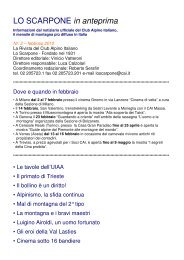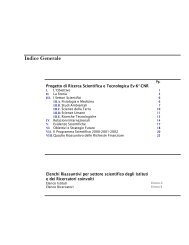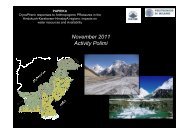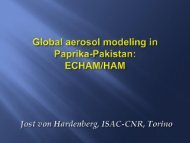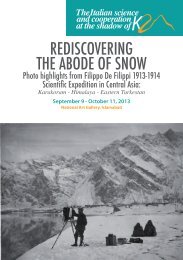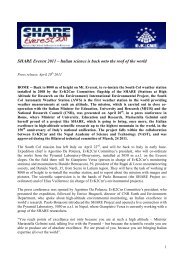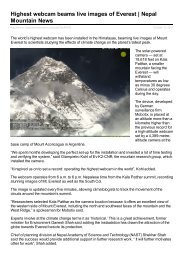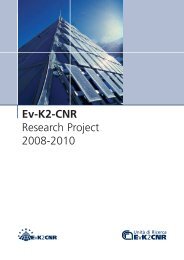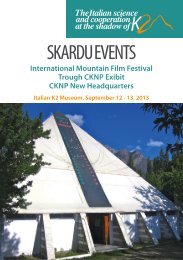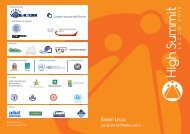Annual Report 2006 - Ev-K2-CNR
Annual Report 2006 - Ev-K2-CNR
Annual Report 2006 - Ev-K2-CNR
You also want an ePaper? Increase the reach of your titles
YUMPU automatically turns print PDFs into web optimized ePapers that Google loves.
ar<strong>2006</strong> 19-09-2007 10:36 Pagina 27<br />
Earth Sciences<br />
Research groups leaded by Prof. Claudio Smiraglia, Earth<br />
Sciences Department of the University of Milan, and Prof.<br />
Franco Rolfo, Mineralogical and Petrologic Sciences<br />
Department of the University of Torino, organized an expedition<br />
to North China in Gasherbrum and <strong>K2</strong> areas (Shaksgam<br />
Valley), in July, in order to carry out the following glaciological<br />
and geological research programs:<br />
CONTRIBUTION TO THE STUDY OF GEOLOGICAL<br />
TRIM AND CONTINENTAL COLLISION PROCESS IN<br />
NORTHWEST HIMALAYA AND KARAKORUM<br />
Principal investigator: Prof. Franco Rolfo – University of<br />
Torino<br />
The aim of this research project was to complete the already<br />
available information about the geological asset in Northern<br />
regions of Karakorum. The specific objectives were to complete<br />
the geologic mapping of the area and to define the<br />
tectonometamorphic and magmatic evolution of basement<br />
units occurring in area.<br />
During the field campaign, carried out by Prof. Franco Rolfo<br />
and Dr. Chiara Groppo, the geological asset was defined and<br />
metamorphic rocks were collected along the Aghil Chain to<br />
the Shaksgam Valley. The preliminary analysis showed the<br />
presence of low-grade metamorphic rocks (principally<br />
metabasic, phyllite schist and subordinated conglomerates<br />
and quartzite) and associated magmatic rocks (granitoids<br />
and granodiorites with subordinated gabbroic), involved in<br />
deforming processes probably linked to the recent structure<br />
of the Aghil Chain and to its deformation along the<br />
Karakorum fault.<br />
GLACIOLOGICAL RESEARCH IN THE<br />
<strong>K2</strong>-GASHERBRUM NORTH SIDE<br />
Principal investigator: Prof. Claudio Smiraglia – University of<br />
Milan<br />
The expedition to the North side of Gasherbrum, Karakoram<br />
was designed to investigate the conditions on Urdok glacier,<br />
which is fed from the northern and eastern slopes of<br />
Gasherbrum I, installing a network of stakes on the ablation<br />
zone and digging snow pits in the accumulation zone.<br />
Especially the determination of accumulation would increase<br />
the knowledge about glacier conditions and dynamics, due<br />
to the an almost complete lack of such data in the<br />
Karakoram to date. As members of the glaciological team,<br />
Christoph Mayer from the Commission for Glaciology in<br />
Munich and Astrid Lambrecht from the Institute for<br />
Meteorology in Innsbruck, took part. In order to have the<br />
necessary reference data a simple weather station and a GPS<br />
master station were installed at the base camp close to the<br />
snout of Urdok glacier. In total 17 stakes were drilled in the<br />
lower part of Urdok glacier forming three groups. First were<br />
7 stakes in the lowermost part of the glacier providing information<br />
about ice ablation under the debris cover, changes in<br />
debris thickness during the expedition, ice velocity and ice<br />
temperature and temperature gradients at some of the<br />
stakes.<br />
In addition, six stakes were drilled into a higher part of the<br />
ablation zone, for investigation of a more active zone of the<br />
glacier. Here, the same measurements have been carried out<br />
as in the lower profile. The third group of stakes (four stakes)<br />
was placed for a special experiment, investigating the formation<br />
of the large ice pinnacles, which are a characteristic feature<br />
of glaciers in this area.<br />
annual report <strong>2006</strong>






